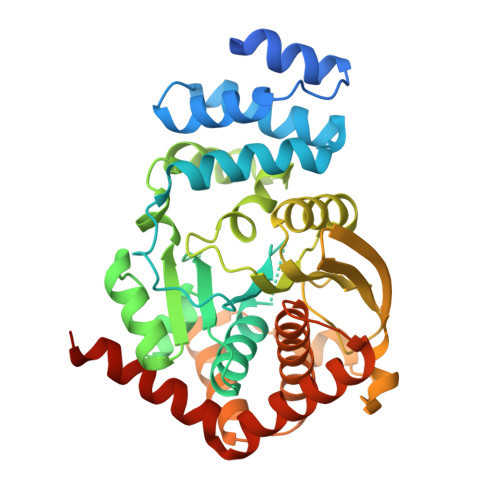Repurposing the Chemical Scaffold of the Anti-Arthritic Drug Lobenzarit to Target Tryptophan Biosynthesis in Mycobacterium tuberculosis.
Evans, G.L., Gamage, S.A., Bulloch, E.M., Baker, E.N., Denny, W.A., Lott, J.S.(2014) Chembiochem 15: 852-864
- PubMed: 24623674
- DOI: https://doi.org/10.1002/cbic.201300628
- Primary Citation of Related Structures:
4GIU, 4GKM, 4IJ1, 4M0R - PubMed Abstract:
The emergence of extensively drug-resistant strains of Mycobacterium tuberculosis (Mtb) highlights the need for new therapeutics to treat tuberculosis. We are attempting to fast-track a targeted approach to drug design by generating analogues of a validated hit from molecular library screening that shares its chemical scaffold with a current therapeutic, the anti-arthritic drug Lobenzarit (LBZ). Our target, anthranilate phosphoribosyltransferase (AnPRT), is an enzyme from the tryptophan biosynthetic pathway in Mtb. A bifurcated hydrogen bond was found to be a key feature of the LBZ-like chemical scaffold and critical for enzyme inhibition. We have determined crystal structures of compounds in complex with the enzyme that indicate that the bifurcated hydrogen bond assists in orientating compounds in the correct conformation to interact with key residues in the substrate-binding tunnel of Mtb-AnPRT. Characterising the inhibitory potency of the hit and its analogues in different ways proved useful, due to the multiple substrates and substrate binding sites of this enzyme. Binding in a site other than the catalytic site was found to be associated with partial inhibition. An analogue, 2-(2-5-methylcarboxyphenylamino)-3-methylbenzoic acid, that bound at the catalytic site and caused complete, rather than partial, inhibition of enzyme activity was found. Therefore, we designed and synthesised an extended version of the scaffold on the basis of this observation. The resultant compound, 2,6-bis-(2-carboxyphenylamino)benzoate, is a 40-fold more potent inhibitor of the enzyme than the original hit and provides direction for further structure-based drug design.
Organizational Affiliation:
School of Biological Sciences, Faculty of Science, University of Auckland, Private Bag 92019, Auckland, 1142 (New Zealand). [email protected].

















